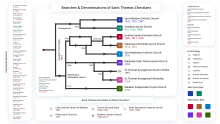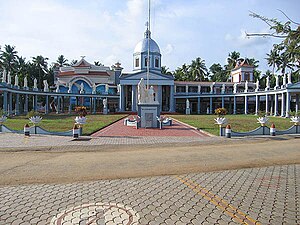Christianity in Kerala


Christianity is the third-largest practiced religion in Kerala, accounting for 18% of the population according to the 2001 Indian census.[1] According to traditional accounts, Thomas the Apostle sailed to the Malabar region in 52 AD and introduced Christianity to the area.[2] Although a minority, the Christian population of Kerala is proportionally much larger than that of India as a whole. A significant portion of the Indian Christian population resides in the state.[3][4]
History[edit]
This section needs additional citations for verification. (July 2020) |

The tradition of origin among Saint Thomas Christians relates to the arrival of Thomas, one of the 12 disciples of Jesus, at the ancient seaport Muziris on the Kerala coast in AD 52.[5][6][2][7][8]
It is also possible for Aramaic-speaking Jews from Galilee to make a trip to Kerala in the 1st century. The Cochin Jews are known to have existed in Kerala around that time.

The earliest known source connecting the apostle to India is the Acts of Thomas, likely written in the early 3rd century, perhaps in Edessa. The text describes Thomas' efforts in bringing Christianity to Northwest India, specifically in the Indo-Parthian Kingdom.[9]
According to traditional accounts such as the "Thomma Parvam" ("Song of Thomas"), he is generally described as arriving in or around Maliankara and founding Seven Churches and half churches, or Ezharapallikal: Kodungallur, Kollam, Niranam, Nilackal (Chayal), Kokkamangalam, Kottakkavu, Palayoor , Thiruvithamcode Arappalli and Aruvithura church (half church). A number of 3rd- and 4th-century Roman writers also mention Thomas' trip to India, including Ambrose of Milan, Gregory of Nazianzus, Jerome, and Ephrem the Syrian, while Eusebius of Caesarea records that Clement of Alexandria's teacher Pantaenus from Alexandria visited a Christian community in India using the Gospel of Matthew in Hebrew language in the 2nd century.[10][11] Byzantine traveller Cosmas Indicopleustes wrote of Syrian Christians he met in Malabar and Sri Lanka in the 6th century.[12][13][14] In 883 the English king Alfred the Great reportedly sent a mission and gifts to Saint Thomas' tomb in India.[15] During the Crusades, distorted accounts of the Saint Thomas Christians and the Nestorian Church gave rise to the European legend of Prester John.[16]
Religious education[edit]
Denominations[edit]
Denominations among all Christians in Kerala
The 2011 Indian census found a total of 6,411,269 Christians in Kerala,[1] with their various denominations as stated: Saint Thomas Christians (including multiple Catholic, Oriental Orthodox and Protestant bodies) constituted 70.73% of the Christians of Kerala, followed by Latin Catholics at 13.3%, Pentecostals at 4.3%, CSI at 4.5%, Dalit Christians at 2.6% and other Protestant groups (such as Lutheran, Calvinist and other charismatic churches) at 5.9%.
The Saint Thomas Christians (Nasrani) of Kerala primarily belong to churches which use the East Syriac Rite (Syro-Malabar Catholic Church and Chaldean Syrian Church) and West Syriac Rite (Jacobite Syrian Christian Church, Malankara Orthodox Syrian Church, Mar Thoma Syrian Church, St. Thomas Evangelical Church of India, Syro-Malankara Catholic Church and the Malabar Independent Syrian Church). The Church of South India belongs to the Anglican Communion and Saint Thomas Anglicans are theologically and liturgically similar to Anglicans elsewhere. Pentecostal Saint Thomas Christians, like other Pentecostals, are riteless (nonliturgical).[20] As of 2005[update], Saint Thomas Christians composed 12.5% of the total population of Kerala.[21][22]

The Mar Thoma Syrian Church and St. Thomas Evangelical Church of India are Oriental Protestant churches.[23][24] The Salvation Army also maintains a presence in Kerala.[citation needed]
In 2016, 61% of Christians in the state were Catholics, which includes Eastern Catholics and Latin Catholics.[25] The percentage of Catholics among Christians is the highest in Thrissur district.
Major Pentecostal denominations in Kerala include the India Pentecostal Church of God, Assemblies of God in India, Church of God (Full Gospel) in India, and The Pentecostal Mission.
See also[edit]
- Caste system among South Asian Christians
- Goan Catholics
- East Indian Catholics
- Mangalorean Catholics
References[edit]
- ^ a b "Census of India". Retrieved 2009-04-12.
- ^ a b Fahlbusch, Erwin; Bromiley, Geoffrey William; Lochman, Jan Milic (2008). The Encyclodedia of Christianity. Wm. B. Eerdmans Publishing. p. 285. ISBN 978-0-8028-2417-2.
- ^ "Christianity in India". Members.tripod.com. Retrieved 2013-12-16.
- ^ Compiled by Robert Eric Frykenberg (2005-07-01). "Timeline". Ctlibrary.com. Archived from the original on 2013-10-18. Retrieved 2013-12-16.
- ^ "The Surprisingly Early History of Christianity in India".
- ^ "Thomas the Apostole". stthoma.com. Archived from the original on 8 February 2011. Retrieved 11 January 2022.
- ^ "Syrian Christians in Muslim Society", Syrian Christians in a Muslim Society: An Interpretation, Princeton: Princeton University Press, pp. 1–98, 2015-12-31, doi:10.1515/9781400872589-003, ISBN 978-1-4008-7258-9, retrieved 2020-11-04
- ^ Jullien, Christelle (2011-05-15). "Origin of Christianity in India. A historiographical Critique. Delhi, Media House, 2007, 392 p." Abstracta Iranica. 31. doi:10.4000/abstractairanica.39686. ISSN 0240-8910.
- ^ Cordier, Henri (1920). Marco Polo; notes and addenda to Sir Henry Yule's edition, containing the results of recent research and discovery.
St. Ephraem the Syrian (born about A.D. 300, died about 378), who spent most of his life at Edessa, in Mesopotamia, states that the Apostle was martyred in ' India,' and that his relics were taken thence to Edessa. That St. Thomas evangelized the Parthians, is stated by Origen (born A.D. 185 or 186, died about 251-254). Eusebius (bishop of Caesarea Palaestinae from A.D. 315 to about 340) says the same
- ^ Eusebius, Book V Chapter 10 "Pantaenus the Philosopher"; Frykenberg (2008), p. 103; Baum & Winkler (2003), p. 52; Medlycott (1912); Whitehouse (1873), pp. 12–20.
- ^ "Indian Christianity".
- ^ Cosmas Indicopleustes (24 June 2010). J. W. McCrindle (ed.). The Christian Topography of Cosmas, an Egyptian Monk: Translated from the Greek, and Edited with Notes and Introduction (2010 ed.). Cambridge University Press. pp. 48, 119–120, 365–366. ISBN 978-1-108-01295-9. Retrieved 3 November 2012.
- ^ Walker (2011).
- ^ Frykenberg (2008), pp. 105, 110.
- ^ Frykenberg (2008), p. 112.
- ^ # Silverberg, Robert (1996). The Realm of Prester John, pp. 29–34. Ohio University Press. ISBN 1-84212-409-9.
- ^ Neill, Stephen (2004) [1984]. A History of Christianity in India: The Beginnings to AD 1707. Cambridge: Cambridge University Press. ISBN 9780521548854.
- ^ Devika, J.; Varghese, V. J. (March 2010). To Survive or to flourish? Minority rights and Syrian Christian assertions in 20th century Travancore (PDF). Trivandrum: Centre for Development Studies. Archived from the original (PDF) on 26 May 2012. Retrieved 27 April 2012.
- ^ Surendranath, Nidhi (18 July 2013). "A saint who pioneered girls' education remembered". The Hindu. ISSN 0971-751X. Retrieved 18 June 2022.
.. The first convent was a simple bamboo-mat house at Koonammavu, on the land once administered by Vareed Vakayil. The congregation, under Mother Eliswa, was given the task of teaching girls who had no means to pursue education. St. Joseph's LP School at Koonammavu was set up in 1868 as the first Catholic school for girls in Malabar. Mother Eliswa's mission in life was to educate young girls and she set up several girls' schools here. ..
- ^ John, Stanley J. Valayil C. (19 February 2018). Transnational Religious Organization and Practice: A Contextual Analysis of Kerala Pentecostal Churches in Kuwait. BRILL. pp. 167, 203. ISBN 978-90-04-36101-0.
- ^ Anderson, Allan; Tang, Edmond (2005). Asian and Pentecostal: The Charismatic Face of Christianity in Asia. OCMS. pp. 192 to 193, 195 to 196, 203 to 204. ISBN 978-1-870345-43-9.
- ^ Bergunder, Michael (6 June 2008). The South Indian Pentecostal Movement in the Twentieth Century. Wm. B. Eerdmans Publishing. pp. 15 to 16, 26 to 30, 37 to 57. ISBN 978-0-8028-2734-0.
- ^ Leustean, Lucian N. (30 May 2014). Eastern Christianity and Politics in the Twenty-First Century. Routledge. p. 568. ISBN 978-1-317-81866-3.
The Syrian Orthodox also became the target of Anglican missionary activity, as a result of which the Mar Thoma Church separated from the Orthodox in 1874, adopting the Anglican confession of faith and a reformed Syrian liturgy conforming to Protestant principles.
- ^ Pallikunnil, Jameson K. (2017). The Eucharistic Liturgy: A Liturgical Foundation for Mission in the Malankara Mar Thoma Syrian Church. pp. 48, 53. ISBN 978-1-5246-7652-0.
Metropolitan Juhanon Mar Thoma called it "a Protestant Church in an oriental grab."...As a reformed Oriental Church, it agrees with the reformed doctrines of the Western Churches. Therefore, there is much in common in faith and doctrine between the MTC and the reformed Churches of the West. As the Church now sees it, just as the Anglican Church is a Western Reformed Church, the MTC is an Eastern Reformed Church. At the same time as it continues in the apostolic episcopal tradition and ancient oriental practices, it has much in common with the Oriental Orthodox Churches. Thus, it is regarded as a "bridging Church".
- ^ "Religious denominations of Kerala" (PDF). Archived from the original (PDF) on 2018-04-17. Retrieved 2021-05-08.
Works cited[edit]
- Baum, Wilhelm; Winkler, Dietmar W. (2003). The Church of the East: A Concise History. London-New York: Routledge-Curzon. ISBN 9781134430192.
- Eusebius. Knight, Kevin (ed.). Church History. Translated by McGiffert, Arthur Cushman.. Book V Chapter 10.
- Frykenberg, Robert E. (2008). Christianity in India: From Beginnings to the Present. Oxford: Oxford University Press. ISBN 9780198263777.
- Medlycott, A (1912). "St. Thomas Christians". The Catholic Encyclopedia. New York: Robert Appleton Company. Retrieved 4 July 2021.
- Walker, Joel T. (2011). "Fars". In Sebastian P. Brock; Aaron M. Butts; George A. Kiraz; Lucas Van Rompay (eds.). Gorgias Encyclopedic Dictionary of the Syriac Heritage: Electronic Edition. Gorgias Press. Retrieved 22 September 2016.
- Whitehouse, Thomas (1873). Lingerings of light in a dark land: Researches into the Syrian church of Malabar. William Brown and Co.
Further reading[edit]
- George K.M.,`Christianity in India Through the Centuries`,Authentic Books, Secunderabad,2007,2009.(ISBN 978-81-7362-786-6).
- Benedict Vadakkekara,`Origin of Christianity in India`,Media House, Delhi,2007.ISBN 81-7495-258-6.
- Agur C.M.,`Church History of Travancore`,Madras,1903 Reprint:Asian Educational Services, New Delhi,1990. (ISBN 81-206-0594-2).
- Visvanathan Susan,`The Christians of Kerala`,Oxford University Press, Delhi1993,1999.(ISBN 0195647998)
- George Menachery,`The St. Thomas Christian Encyclopaedia of India`,SARAS,Ed.Prof. George Menachery, Ollur,Vol.I 1982, Vol.II 1973, Vol. III 2009.
- George Menachery,`Indian Church History Classics`,SARAS,Ed.Prof. George Menachery, Ollur,Vol.I The Nazranies 1998.
- C. I. Issac, The Evolution of Christian Church in India, ISBN 978 81 7255 056 1 2014, Soorygatha Publishers, PB No 3517, Kochi 682 035
